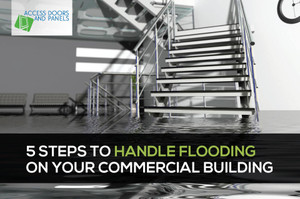5 Steps to Handle Flooding on Your Commercial Building
Posted by Access Doors and Panels on 18th Aug 2021
Nature can sometimes be unforgiving. The elements can cause unexpected damage to your establishment and wreak havoc if you're unprepared. The best solution is always to have a plan in place, especially true for a common destructive force: Flooding.
Interesting Read: "The Impact of Climate on Construction."
To protect your business from flood damage, you must carry out some necessary steps to mitigate the damage, prevent it before it happens, and cover your losses if the damage is unavoidable. This article aims to discuss how you can protect your commercial business against flood damage. Here are the steps you can take:
#1. Plan to Manage Risks
Planning is paramount to everything when it comes to running a business. Without a plan, there is no general direction and purpose to guide the decisions of any undertakings. Needless to say, when managing risks, one needs a plan to ensure that events go smoothly and, if possible, without any trouble.
When planning for a flood, there is no better plan than a business continuity plan. This plan contains all the information needed to jump-start your establishment again after a crisis or an incident. It's part of the business plan and will depend heavily on the size and complexity of the business.
#2. Get Insurance
Getting flood insurance for your business is one of the most crucial things you can do to protect your business. Typically, standard commercial property insurance does not cover floods, so make sure you get flood insurance through the National Flood Insurance Program of the national govt.
#3. Hire a Professional to Design and Construct Your Project
Hiring a licensed professional to design and construct your building will ensure that it comes with flood control features that will lessen the impact of flood damage. One way of doing this control is by installing a Floodtight floor hatch. The hatch prevents any water from coming into any utility areas hidden under the floor of the building.
They will also advise you to begin planning for flooding during the design and construction of your facility, mainly if you are located near the coast or in a high-risk flood zone. If your structure is on the water and in a flood-prone area, consider raising it and installing hurricane-glass windows and storm shutters for the openings.
#4. Do a General Clean-up and Inspection
Doing a general clean-up of the area will allow you to assess any possible sites that may be prone to flood damage. It also clears the place of any material that can increase the effects of hazards brought by moisture. Clean up gutters, downspouts, roof, and perimeter drains before a storm arrives to avoid water from backing up into your building.
#5. Deploy Flood Barriers When Needed
Flood barriers are essential products for flood control. You can employ a variety of flood barriers to help flood-proof your commercial enterprise:
Aqua-Barrier Water Inflated Dams: The ultimate flood barrier for business regions is aqua-barrier water inflated dams. These fantastic instruments will protect your business by being strategically placed around the facilities, preventing intrusive water from causing damage.
Metal Flood Barriers: These products are excellent solutions to protect your enterprise. It shields it from high-velocity water loads. In flood-prone places worldwide, these highly resistant metal flooding prevention systems provide a lengthy and effective flood barrier.
Conclusion
Being prepared is always a good habit. Expecting things to go south and creating a contingency will allow you to recover quickly from anything that may hinder your progress. Make sure to consult a professional who can give you a piece of solid advice before deciding anything for your next project.

